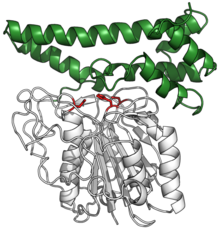Legumain
| Legumain | |||||||||
|---|---|---|---|---|---|---|---|---|---|
|
 Human pro-legumain with catalytic triad in red, bound to its auto-inhibitory C-terminal prodomain in green. (PDB: 4FGU) Human pro-legumain with catalytic triad in red, bound to its auto-inhibitory C-terminal prodomain in green. (PDB: 4FGU) |
|||||||||
| Identifiers | |||||||||
| EC number | 3.4.22.34 | ||||||||
| CAS number | 149371-18-6 | ||||||||
| Databases | |||||||||
| IntEnz | IntEnz view | ||||||||
| BRENDA | BRENDA entry | ||||||||
| ExPASy | NiceZyme view | ||||||||
| KEGG | KEGG entry | ||||||||
| MetaCyc | metabolic pathway | ||||||||
| PRIAM | profile | ||||||||
| PDB structures | RCSB PDB PDBe PDBsum | ||||||||
|
|||||||||
| Search | |
|---|---|
| PMC | articles |
| PubMed | articles |
| NCBI | proteins |
 Human legumain with catalytic triad in red, bound to product in black. (PDB: 4AW9)
Human legumain with catalytic triad in red, bound to product in black. (PDB: 4AW9)
Legumain (EC 3.4.22.34, asparaginyl endopeptidase, citvac, proteinase B, hemoglobinase, PRSC1 gene product or LGMN (Homo sapiens), vicilin peptidohydrolase, bean endopeptidase) is an enzyme that in humans is encoded by the LGMN gene (previous symbol PRSC1).
This enzyme was originally identified in the vacuoles of legume seeds, and was subsequently identified the lysosomes of mammals and Schistosoma mansoni. They are now known to be present in a range of plants and animals.
This enzyme catalyses the following chemical reaction:
Both plant and animal legumains are most active in acidic environments.
Legmains are produced as inactive precursor zymogens. their C-terminal domain binds over their active site (where a substrate would normally bind), inhibiting activity. Once in the acidic environment of the vacuole or lysosome, the prodomain is cleaved off to reveal the active enzyme.
...
Wikipedia
